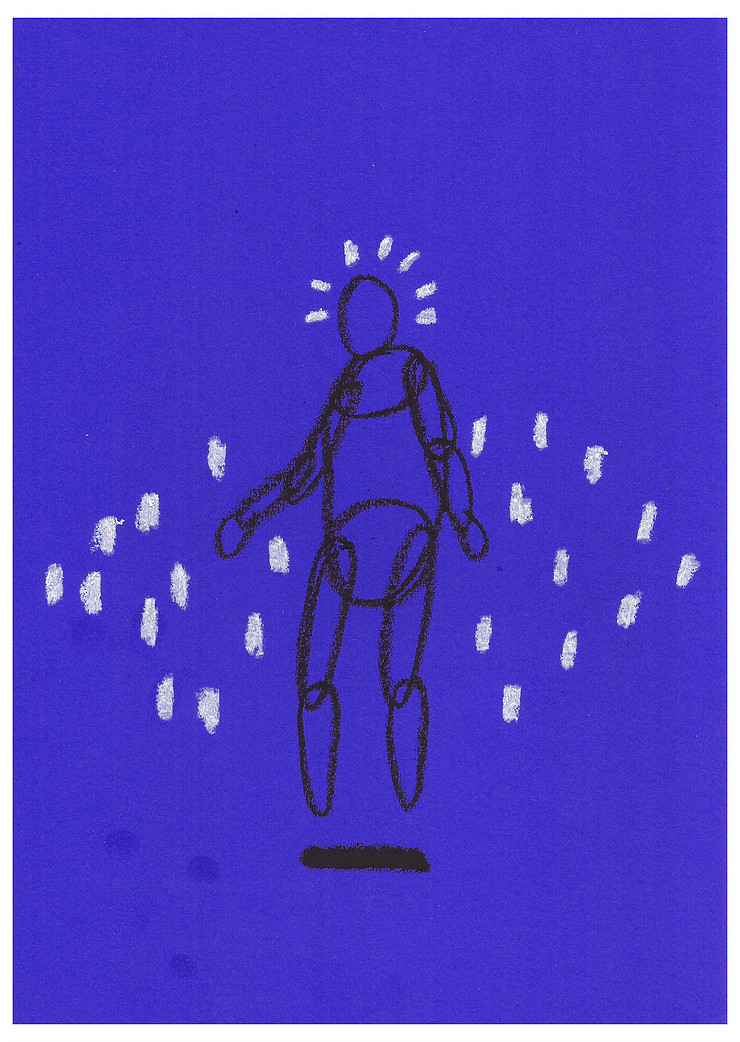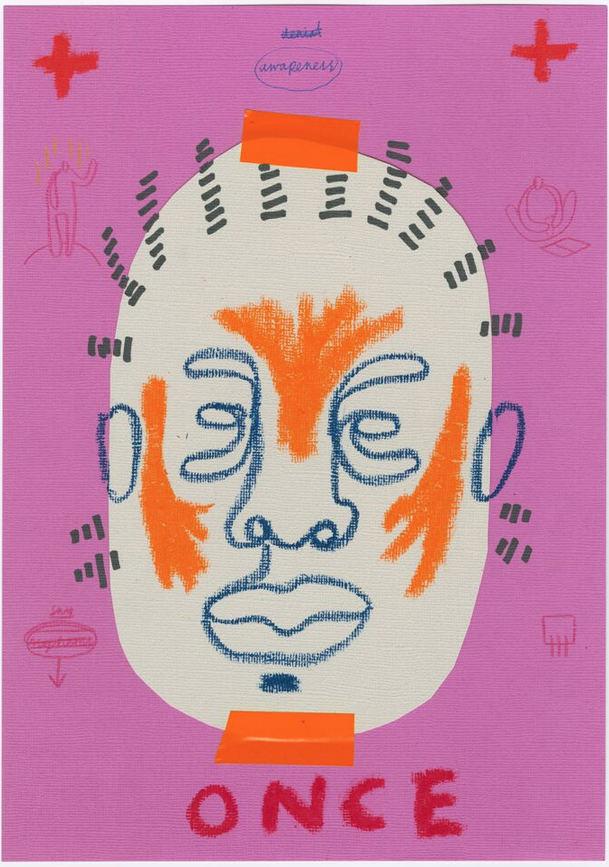Varoom 39: Finding the Middle – Joy Miessi
Joy Miessi transforms personal experiences into visual memorabilia through mixed media work. Both an illustrator and painter, Joy’s work reveals a varying range of themes, from past moments and conversations to intimate thoughts. In this extract from Varoom 39, Aisha Ayoade talks to Joy about the concept of nostalgia and how the past is made present in their work.

Accepting, Joy Miessi, 2018
Varoom: You had your first solo exhibiton “Do you know your middle?” in 2018. What’s the story behind the name?
Joy: The title came from my mum. From when I was young until now, she begins the process of parting my hair by asking me ‘Do you know your middle?’. At first, I took this literally and understood it to mean ‘am I aware of where the middle of my hair is, in case she misaligns my central parting’. It didn’t always require an answer, as she’d always start separating the hairs straight away. As I’ve grown older, and with the time I’ve had to reflect over the years whilst getting my hair braided, I’ve understood the question to mean so much more than literal. To me, it’s come to mean knowing who I am with certainty and pride even if I’m far away from home – my middle.
How did you capture memory through the work you made for the series?
Behind almost every painting in this series is a photograph. I started the process of making work by spending time at home and going through the albums that we have. Many of them sparked memories and stories and some of them were unfamiliar. I chose a few and chatted with my mum about the people in the photos, her perspective, and it sent us down a road of memories. The painting process was simply reflecting back on the memory – using words, colours and shapes that I could recall and bringing them forward into line drawings and text.

What Are You Asking For, Joy Miessi, 2018
Bringing nostalgic feelings into the work I create is part of my character. Naturally, I find myself reminiscing or trying to remember past events and conversations in order to strengthen the memory. I forget stories and key elements all the time, so to be able to turn these memories – many of which don’t have photographs documenting them – into artworks, adds permanence to the stories that I value.
I notice some of your work is reminiscent of the work of Jean-Micheal Basquiat. To what degree would you say his work inspires yours?
I like that Basquiat’s work is free-flowing in composition and unapologetic in its message. My favourite works by Basquiat are the collaborations with artist, Andy Warhol. Though I admire both of their works greatly, most of my inspiration comes from British/Congolese culture, from storytelling to the signage in both environments. My work is in response to my day-to-day, conversations, relationships, family etc – all these things make their way into my art. There’s a certain order that my work has to be read to be understood, and the repeat symbology holds a story that’s unique to my life experiences.

Glory, Joy Miessi, 2018
“Do you know your middle?” was as much an exhibition as it was an experience, how did the music and atmosphere you created align with your visual work?
To me, sound makes a memory real. I worked with my mum to create a playlist for the exhibition. It features all of her favourite songs, which I remember listening to in the car or in the background at home playing from our tiny blue radio. A few people who heard the playlist, had told me it reminded them of their parents and brought a feeling of nostalgia.
On the last day of the exhibition I invited musicians Touching Bass and Finding Soul to respond to the playlist and my artworks. We had Ahnansé on saxophone, Onome on drums, Shirley Tetteh on bass and Brother Portrait alongside Belinda Zhawi who shared live poetry and spoken word with the audience. The event was about celebration and creating something memorable and present from a series on reflection.
Your work is always layered – both visually and conceptually. Can you talk me through your process?
For me research starts by spending time looking through old film and photographs at home or images from my phone, which then develops into hours spent reading online. By the end of this, I usually have an idea in mind and can turn this into written notes and scribbles. I reflect on what I’ve found and make a rough thumbnail drawing. From there I start collecting textures, paper and material to build the composition. To this collage of pieces, I start adding layers of text using thoughts, feelings and words from the notes I’ve jotted on my phone and create line drawings that build a story. A lot of the detail and paper textures get lost when scanning and sharing online which is what makes seeing the artworks in real life a different and much more personal experience.

Awareness, Joy Miessi, 2018
How does the focus on your personal experiences translate when you’re doing collaborations with commercial brands like Asos, Nike and Gucci?
My work has always centered around myself and so working in this way with a client made me wary at first. However, working on those projects was a very different experience and I was encouraged to keep my work personal and given a lot of room to create freely.
What do you set out to achieve through your artwork more generally?
I hope that the stories that my work reveals create conversation and perhaps add further representation to a large part of the art world that remains overlooked – the work of minority artists. There are many different sectors of marginalised people in the creative industries and they intersect in lots of ways. From my own experience I’ve noticed it as pattern in workload, where commissions become more frequent during Black History Month or LGBT History Month whilst at other times the flow can be quite stagnant.
I’m grateful to know of so many talented Black artists in the UK who continue to create despite this and I think that is where more support should be shown, whether it’s investing in diverse projects or commissioning more illustrators.
Read the full article in Varooom 39
Back to News Page
